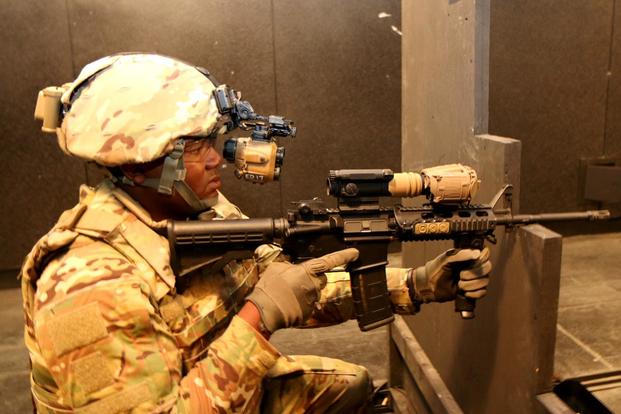U.S. Army infantry and other ground combat soldiers may start receiving dual-tubed, binocular-style night vision goggles by this fall, according to service officials working to increase soldier lethality.
The Army announced in February that it has money in its fiscal 2019 budget to fund the effort to give soldiers greater depth perception than the current single-tubed Enhanced Night Vision Goggles and AN/PVS 14s.
The ENVG B is a "dual-tubed fusion so we can fight day and night, and we are now putting the capability to see, whether it is reticles, sights and everything else, into the dismounted soldier -- so think heads-up display version 1.0," Brig. Gen. Christopher Donahue, commandant of the Infantry School at Fort Benning, Georgia, and soldier lethality cross functional team leader, told an audience recently at the Association of the United States Army's Global Force Symposium in Huntsville, Alabama.
Soldier lethality is one of the Army's six modernization priorities, along with long-range precision fires; the next-generation combat vehicle; future vertical lift; a mobile and expeditionary network; and air and missile defense capabilities.
Related content:
- Army to Test First Next-Gen Ground Combat Vehicles in 2019
- Army Unveils Family of Future Vertical Lift Helicopters
- US Would Fight Without Air Support for Weeks if War With Russia Began
Each priority has a dedicated cross-functional team, made up of program managers, requirements officials and experienced soldiers to help develop and field new technologies faster than ever before, Army officials say.
Defense Secretary Jim Mattis recently established the Close Combat Lethality Task Force, "a parallel effort" that is supporting the Army's efforts to improve soldier lethality, said Gen. Stephen Townsend, commander of Army Training and Doctrine Command.
"U.S. close-combat soldiers and Marines, in our squads and platoons, do not overmatch our opponents," Townsend said. "Our adversaries have access to technology and weapons that have enabled them to close the gap between our forces -- night vision devices, weapons and munitions, and improved body armor are just a few examples of where they have closed the gap."
For now, the effort is focused on improving lethality in what the Army is calling the "close-combat 100,000," he said.
"There are approximately 100,000 dismounted soldiers -- infantry, cavalry, engineers, medics and the [forward observers] that accompany them, soldiers that close with and destroy the enemy in close combat," Townsend said. "They must have the capabilities that increase their lethality, mobility and survivability, and they've got to have room to counter emerging threats in the future."
Currently, most soldiers still use basic night-vision PVS-14, which takes ambient light from the stars and the moon.
The Army began fielding the first generation of the Enhanced Night Vision Goggle in 2009. The ENVG technology consists of a traditional infrared image intensifier similar to the PVS-14 and a thermal camera. The system fuses the IR with the thermal capability into one display.
So far, the Army has fielded about 20,000 of the slightly improved ENVG II. The ENVG III weighs about two pounds and features wireless capability. The service intends to field about 64,000 ENVG IIIs, Army officials said.
At the same time, the Army began rapidly developing the dual-tubed ENVG B late last year, Donahue said. The service brought together representatives from industry to sit down with program managers and soldiers to help develop a requirement and find a solution.
"ENVG B already has three of six soldier touchpoints -- industry is there, the right soldiers are there, specifically a bunch of squad leaders from 25th Infantry Division, 82nd Airborne Division for that one," Donahue said.
"They are getting immediate feedback of what should be on that prototype so when we do get that out to the force in October, that final version will have the right stuff on it," he said.
The soldier lethality CFT has also put a priority on replacing the M249 squad automatic weapon, followed by the M4 carbine with weapons more potent than the Army's 5.56mm Enhanced Performance Round, Donahue said.
-- Matthew Cox can be reached at matthew.cox@military.com.










